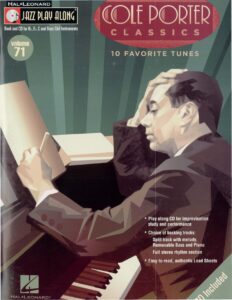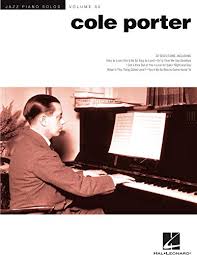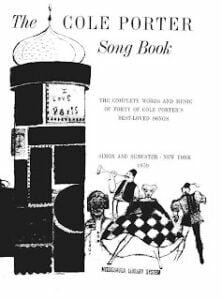Table of Contents
Come join us now, and enjoy playing your beloved music and browse through great scores of every level and styles!
Can’t find the songbook you’re looking for? Please, email us at: sheetmusiclibrarypdf@gmail.com We’d like to help you!
Remembering Cole Porter, born on this day in 1891.

Best Sheet Music download from our Library.

Please, subscribe to our Library.
If you are already a subscriber, please, check our NEW SCORES’ page every month for new sheet music. THANK YOU!
Cole Porter: The Sophisticated Siren of American Song.

Cole Albert Porter (June 9, 1891 – October 15, 1964) stands as a colossus in the pantheon of American music. More than just a composer or lyricist, he was the epitome of urbane wit, musical sophistication, and enduring glamour. His songs, characterized by their complex harmonies, ingenious rhymes, and often slyly subversive themes, became the sophisticated soundtrack of the Jazz Age, the Great Depression, and beyond, continuing to captivate audiences and performers nearly a century later.

Biography: From Peru to Paris to the Penthouse
- Privileged Beginnings & Musical Prodigy (1891-1913): Born into immense wealth in Peru, Indiana, Porter’s musical talents were evident early. His mother, Kate, a strong influence, ensured he received rigorous training. By age 10, he was playing violin and piano proficiently and composing. He attended Worcester Academy in Massachusetts and then Yale University (1909-1913), where he flourished socially and musically. He wrote over 300 songs, including fight songs still used today (“Bulldog,” “Bingo Eli Yale”), and became president of the Glee Club and a member of the prestigious Scroll and Key society.
- Finding His Voice: Europe and Early Struggles (1914-1928): Briefly attending Harvard Law School (switching to music on advice), Porter soon departed for the vibrant artistic scene of Paris in 1917. He moved in elite social circles, traveled extensively, and married the wealthy, beautiful, and socially connected Linda Lee Thomas in 1919. Their marriage, widely believed to be one of mutual affection and convenience given Porter’s homosexuality, provided him stability and social access. Despite his privileged life, his early Broadway efforts (e.g., See America First, 1916; Hitchy-Koo, 1919) were flops. He honed his craft privately, absorbing European influences while developing his unique voice.
- Breakthrough and Golden Age (1928-1948): Porter’s true arrival came with the musical Paris (1928), featuring the hit “Let’s Do It (Let’s Fall in Love).” This inaugurated an unparalleled two-decade run of success:
- Hit Shows: Fifty Million Frenchmen (1929), Wake Up and Dream! (1929), The New Yorkers (1930 – featuring “Love for Sale”), Gay Divorce (1932 – featuring “Night and Day,” his first major standard), Anything Goes (1934 – featuring “I Get a Kick Out of You,” “You’re the Top,” “Anything Goes,” “Blow, Gabriel, Blow”), Jubilee (1935 – featuring “Begin the Beguine,” “Just One of Those Things”), Red, Hot and Blue! (1936 – featuring “It’s De-Lovely”), Leave It to Me! (1938 – featuring “My Heart Belongs to Daddy”), Du Barry Was a Lady (1939 – featuring “Friendship,” “Do I Love You?”), Panama Hattie (1940), Let’s Face It! (1941), Something for the Boys (1943), Mexican Hayride (1944), Seven Lively Arts (1944 – featuring “Ev’ry Time We Say Goodbye”), Kiss Me, Kate (1948 – featuring “So In Love,” “Wunderbar,” “Too Darn Hot,” “Brush Up Your Shakespeare”).
- Hollywood: Porter also wrote extensively for films, including Born to Dance (1936 – “Easy to Love,” “I’ve Got You Under My Skin”), Rosalie (1937 – “In the Still of the Night”), Broadway Melody of 1940 (“Begin the Beguine”), and High Society (1956 – “True Love,” “You’re Sensational,” “Who Wants to Be a Millionaire?”).
- Tragedy and Resilience (1937 onwards): In 1937, a horrific horseback riding accident crushed both of Porter’s legs, leaving him in constant, excruciating pain and requiring over 30 surgeries over the next 27 years. Despite this, his creative output remained remarkably high, culminating in the massive success of Kiss Me, Kate (1948), arguably his masterpiece. He continued writing, though with less frequency and success (Out of This World, 1950; Can-Can, 1953; Silk Stockings, 1955).
- Final Years and Legacy (1958-1964): Devastated by Linda’s death in 1954 and increasingly debilitated by his injuries and subsequent depression, Porter’s later years were marked by isolation. His right leg was amputated in 1958. He died of kidney failure in Santa Monica, California, in 1964.

Musical Style: The Porter Blend
Porter’s style is instantly recognizable and widely imitated, yet never duplicated:
- Lyrical Virtuosity:
- Wit and Sophistication: Clever wordplay, double entendres, sophisticated references (literary, geographical, cultural), and unexpected rhymes (“You’re the Nile,/ You’re the Tower of Pisa,/ You’re the smile/ On the Mona Lisa”).
- List Songs: Master of the catalog song, piling up witty comparisons (“You’re the Top,” “Let’s Do It,” “Can-Can”).
- Emotional Depth: Beneath the wit lay profound expressions of love, longing, and loss (“Ev’ry Time We Say Goodbye,” “So In Love,” “I Love Paris,” “In the Still of the Night”). He captured both cynicism and romantic yearning.
- Daring Subject Matter: Explored risqué themes like prostitution (“Love for Sale”), gold-digging (“My Heart Belongs to Daddy”), and illicit passion long before it was common, often cloaked in cleverness.
- Musical Sophistication:
- Complex Harmonies: Used extended chords (ninths, elevenths, thirteenths), chromaticism, and unexpected modulations far beyond typical popular songwriting of the era. He brought a distinctly European classical sensibility (influenced by Ravel, Stravinsky) to American popular music.
- Rhythmic Vitality: Incorporated Latin rhythms (“Begin the Beguine,” “I Love Paris”), jazz syncopation, and driving dance beats (“Too Darn Hot,” “It’s All Right With Me”).
- Memorable Melodies: Created soaring, instantly recognizable tunes that worked perfectly with his complex harmonies and rhythms (“Night and Day,” “I Get a Kick Out of You,” “All Through the Night”).
- Integration: Melody, harmony, and lyrics were meticulously crafted to serve each other, creating a seamless and sophisticated whole.

Legacy: The Enduring Standard
Cole Porter’s legacy is immense and multifaceted:
- The Great American Songbook: Porter contributed more standards to the canon than almost any other composer. His songs are foundational repertoire for jazz singers, cabaret artists, and pop musicians across generations.
- Influence on Songwriters: His sophistication set a high bar. Lyricists from Lorenz Hart to Stephen Sondheim to Lin-Manuel Miranda cite his wit, craft, and emotional range as major influences. Composers admire his harmonic daring and melodic invention.
- Broadway Evolution: Shows like Anything Goes and especially Kiss Me, Kate demonstrated the potential for integration of story, character, and song in musical comedy, paving the way for later integrated musicals. Kiss Me, Kate remains one of the most frequently revived Golden Age musicals.
- Cultural Icon: Porter embodied a certain ideal of cosmopolitan, witty, and slightly decadent elegance. His life and work represent the glamour and sophistication of a bygone era of American high society and artistic achievement.
- Enduring Popularity: His songs are constantly reinterpreted, finding new life in films, commercials, and recordings by artists ranging from Frank Sinatra, Ella Fitzgerald (whose “Songbooks” are definitive), and Tony Bennett to U2, Rufus Wainwright, and Lady Gaga.

Influences: A Cosmopolitan Palette
Porter’s unique sound was a melting pot:
- European Classical: Debussy, Ravel, Stravinsky (for harmony, orchestration, rhythmic complexity).
- American Popular Music: Early ragtime, jazz, and the Broadway traditions of Kern, Gershwin, and Berlin (for song form, vernacular, and rhythmic energy).
- Operetta: The romantic sweep and lyrical sentiment.
- French Popular Song (Chanson): Wit, irony, and cabaret style.
- Global Rhythms: Latin American, Afro-Cuban rhythms absorbed during his travels.

Discography Highlights (Focusing on Key Recordings & Shows):
Note: Porter wrote songs, not typically entire albums during his lifetime. Discography focuses on seminal cast recordings, film soundtracks, and landmark tribute albums.
- Original Cast Recordings:
- Anything Goes (1934, 1962 revival, 1987 revival, 2011 revival)
- Jubilee (1935)
- Red, Hot and Blue! (1936)
- Leave It to Me! (1938)
- Du Barry Was a Lady (1939)
- Panama Hattie (1940)
- Let’s Face It! (1941)
- Something for the Boys (1943)
- Mexican Hayride (1944)
- Kiss Me, Kate (1948 Original Broadway Cast, 1999 Broadway Revival) – Landmark recording.
- Can-Can (1953)
- Silk Stockings (1955)
- Film Soundtracks:
- Born to Dance (1936)
- Rosalie (1937)
- Broadway Melody of 1940 (1940)
- High Society (1956) – Featuring Bing Crosby, Grace Kelly, Frank Sinatra, Louis Armstrong.
- Landmark Tribute Albums:
- Ella Fitzgerald Sings the Cole Porter Songbook (1956, Vols. 1 & 2) – Arguably the most definitive interpretations, setting the standard.
- Frank Sinatra: Songs for Swingin’ Lovers! (1956) – Features definitive Sinatra versions of “I’ve Got You Under My Skin,” “Anything Goes,” etc.
- Red Hot + Blue (1990) – AIDS benefit album featuring diverse artists (U2, Annie Lennox, Sinéad O’Connor, Neneh Cherry) covering Porter songs.
- Essential Compilations/Artist Albums:
- Various Artists: The Complete Cole Porter Songbooks (Multi-disc sets collecting recordings from the 20s-50s).
- Tony Bennett: The Art of Romance (2004), various albums.
- Diana Krall: From This Moment On (2006).
- Mel Tormé: Numerous recordings throughout his career.
- Bobby Short: Celebrating 30 Years at the Carlyle: Cole Porter (1998) – Cabaret master.

Cole Porter: The Top
Cole Porter’s genius lay in his unparalleled fusion of high and low, European elegance and American jazz, razor-sharp wit and deep romanticism. He elevated popular songwriting to an art form, crafting sophisticated, enduring gems that continue to sparkle with intelligence, emotion, and infectious rhythm. From the decadent parties of the 1920s to the stages of today, his songs remain timeless expressions of love, loss, and the sheer joy of sophisticated musical play. He wasn’t just a songwriter; he was, and forever remains, “The Top.”
Notable songs
See also: Category:Compositions by Cole Porter
Shows listed are stage musicals unless otherwise noted. Where the show was later made into a film, the year refers to the stage version. A complete list of Porter’s works is in the Library of Congress in its Cole Porter Collection.
Browse in the Library:
Or browse in the categories menus & download the Library Catalog PDF:
